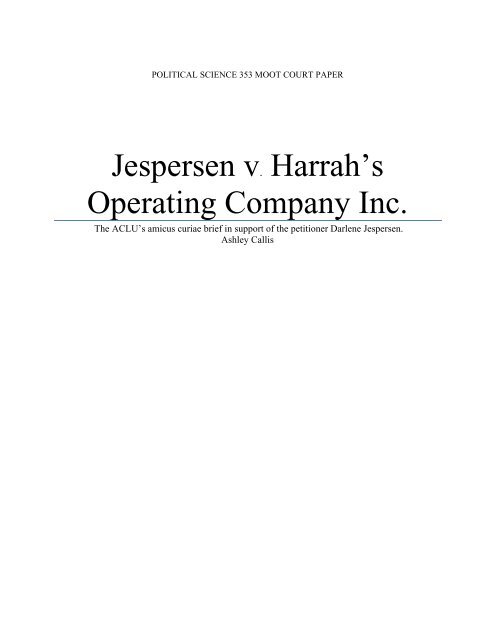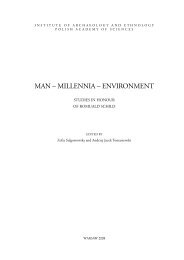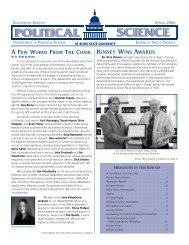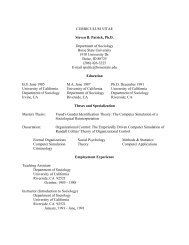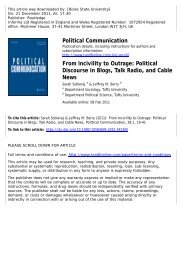Jespersen v. Harrah's Operating Company Inc. - College of Social ...
Jespersen v. Harrah's Operating Company Inc. - College of Social ...
Jespersen v. Harrah's Operating Company Inc. - College of Social ...
Create successful ePaper yourself
Turn your PDF publications into a flip-book with our unique Google optimized e-Paper software.
POLITICAL SCIENCE 353 MOOT COURT PAPER<br />
<strong>Jespersen</strong> v. Harrah’s<br />
<strong>Operating</strong> <strong>Company</strong> <strong>Inc</strong>.<br />
The ACLU’s amicus curiae brief in support <strong>of</strong> the petitioner Darlene <strong>Jespersen</strong>.<br />
Ashley Callis
IN THE<br />
Supreme Court <strong>of</strong> the United States<br />
DARLENE JESPERSEN,<br />
-v-<br />
Petitioner,<br />
HARRAH’S OPERATING COMPANY INC.,<br />
Respondent.<br />
ACLU AMICUS CURAE BRIEF IN FAVOR OF DARLENE JESPERSEN,<br />
PETITIONER<br />
Page | 2
TABLE OF AUTHORITIES<br />
Cases<br />
Page | 3<br />
1. Carroll v. Talman Federal Savings and Loan Association <strong>of</strong> Chicago, 604 F.2d 1028<br />
(1979)<br />
2. Frank v. United Airlines <strong>Inc</strong>., 216 F.3d 845 (2000)<br />
3. <strong>Jespersen</strong> v. Harrah’s <strong>Operating</strong> <strong>Company</strong> <strong>Inc</strong>., 280 F. Supp. 2d 1189 (2002)<br />
4. <strong>Jespersen</strong> v. Harrah’s <strong>Operating</strong> <strong>Company</strong> <strong>Inc</strong>., 444 F.3d 1104 (2006)<br />
5. Nichols v. Azteca Restaurant Enterprises <strong>Inc</strong>., 256 F.3d 864 (2001)<br />
6. Price Waterhouse v. Hopkins, 490 U.S. 228 (1989)<br />
11. ACLU. ACLU.com<br />
Other Authorities<br />
12. Fisk, Catherine L.“ Privacy, Power, and Humiliation At Work: Re-Examining<br />
Appearance Regulation As An Invasion <strong>of</strong> Privacy.” (2006) Duke Law School Faculty<br />
Scholarship Series.<br />
13. Kirshenbaum, Andrea Meryl. “Because <strong>of</strong>…Sex: Rethinking the Protections Afforded<br />
Under Title VII in the Post-Oncale World.” (2006) Albany Law Review, Vol. 69<br />
No.139.<br />
14. Levi, Jennifer L., “ Clothes Don’t Make the Man (or Woman), but Gender Identity<br />
Might.” (2006) Faculty Scholarship Faculty Publications. Western New England<br />
<strong>College</strong> School <strong>of</strong> Law.<br />
15. Lindgren, Ralph J. et al. “The Law <strong>of</strong> Sex Discrimination.” Fourth Edition. Pp 77-109
16. Pizer, Jennifer C. “Facial Discrimination: Darlene <strong>Jespersen</strong>’s Fight Against the<br />
Page | 4<br />
Barbie-fication <strong>of</strong> Bartenders.” (2007) Duke Journal <strong>of</strong> Gender Law & Policy, Vol. 14,<br />
No. 285.<br />
17. “Title VII. Gender Discrimination. Ninth Circuit Holds That Women Can Be Fired for<br />
Refusing to Wear Makeup.” (2006) Harvard Law Review, Vol. 120 No. 2.
INTEREST OF AMICI<br />
Page | 5<br />
The American Civil Liberties Union works “to defend and preserve the individual rights<br />
and liberties that the Constitution and laws <strong>of</strong> the United States guarantee everyone in this<br />
country” (11). It is the duty <strong>of</strong> the ACLU to interviene on behalf <strong>of</strong> those whose Consitutional<br />
rights, and civil liberties are encroached upon, especially when the greivenced party is <strong>of</strong> a<br />
traditionally discrimiated gourp such as, “people <strong>of</strong> color; women; lesbians, gay men, bisexuals<br />
and transgender people; prisoners; and people with disabilities” (11). The question in the case <strong>of</strong><br />
<strong>Jespersen</strong> v. Harrah’s <strong>Operating</strong> Co. <strong>Inc</strong>. is whether an employment issued, gender specific<br />
“uniform” policy is covered as discrimination and a violation <strong>of</strong> Title VII <strong>of</strong> the Civil Liberties<br />
Act. The employment policy at hand requires all female bartenders to wear makeup to work, this<br />
is a perpetuation <strong>of</strong> a sexual-stereotype that women must wear makeup in order to be viewed as<br />
pr<strong>of</strong>essional and attractive. The matter at hand may appear to be a trivial concern about facial<br />
makeup, “but the question arises within a historical continuum <strong>of</strong> dress and decorum demands<br />
that have constrained generations <strong>of</strong> women” (12).<br />
STATEMENT OF THE CASE<br />
In February 2000 Harrah’s <strong>Operating</strong> <strong>Company</strong> began the implementation <strong>of</strong> an<br />
appearance and grooming policy called the “Personal Best” for all beverage department<br />
employees at Harrah’s casino locations. Half <strong>of</strong> the policy requirements were gender neutral, for<br />
instance, “a standard uniform <strong>of</strong> black pants, white shirt, black vest, and black bow tie” (3). The
Page | 6<br />
rest were gender specific requirements: for men, “Hair must not extend below top <strong>of</strong> shirt collar.<br />
Ponytails are prohibited. Hands and fingernails must be clean and nails neatly trimmed at all<br />
times. No colored polish is permitted. Eye and facial makeup is not permitted,” and for females,<br />
“Hair must be teased, curled, or styled. Hair must be worn down at all times. Make up (face<br />
powder, blush and mascara) must be worn and applied neatly in complimentary colors. Lip color<br />
must be worn at all times” (4). For the makeup requirement, Harrah’s hired a cosmetic artist who<br />
gave consultations to the female employees and a diagram <strong>of</strong> how to put on their makeup in each<br />
day for work. By May 5 2000, after Plaintiff, who never wears makeup in her day-to-day life,<br />
made an attempt to conform to the new policy, stated that the makeup made her feel “extremely<br />
uncomfortable, ill and violated,” and would discontinue wearing the required cosmetics. In<br />
response the Defendant <strong>of</strong>fered Plaintiff the opportunity to view Harrah’s job <strong>of</strong>ferings that did<br />
not have a makeup requirement; <strong>Jespersen</strong> refused and was terminated as a result (3). The<br />
Plaintiff filed suit against Defendant with the United States District Court for the District <strong>of</strong><br />
Nevada claiming that Harrah’s <strong>Operating</strong> Co. <strong>Inc</strong>. discriminated against her in violation <strong>of</strong> Title<br />
VII; the District Court <strong>of</strong> Nevada granted a summary judgment for the Defendant. A summary<br />
judgment is a decision in favor <strong>of</strong> one party in order to spare courts from “unnecessary trials”<br />
when the presiding judges determine that the opposing party does not have enough evidence to<br />
make a case (3). In <strong>Jespersen</strong> v. Harrah’s <strong>Operating</strong> Co. <strong>Inc</strong>., the District Court, decided that the<br />
Plaintiff did not have enough evidence to prove discrimination as defined by Title VII. The<br />
Plaintiff appealed the District Court’s summary judgment to the United States Court <strong>of</strong> Appeals<br />
for the Ninth Circuit. The Circuit Court stated that the Plaintiff failed to establish a prima facie
Page | 7<br />
case in accordance with the Supreme Court’s order <strong>of</strong> pro<strong>of</strong> under Title VII, and thus affirmed<br />
the District Court’s summary judgment in favor <strong>of</strong> Harrah’s. As a means <strong>of</strong> last resort, <strong>Jespersen</strong><br />
filed a writ <strong>of</strong> certiorari with The United States Supreme Court.<br />
A. TITILE VII<br />
ARGUMENT<br />
Congress created Title VII <strong>of</strong> the Civil Liberties Act as a means <strong>of</strong> protection against<br />
discrimination towards members <strong>of</strong> traditionally ostracized groups in employment, the most<br />
widely used provisions <strong>of</strong> Title VII are:<br />
(1) It shall be an unlawful employment practice for an employer to fail or<br />
refuse to hire or to discharge any individual, or otherwise to discriminate<br />
against any individual with respect to his compensation, terms conditions,<br />
or privileges <strong>of</strong> employment, because <strong>of</strong> such individual’s race, color,<br />
religion, sex, or national origin or<br />
(2) To limit, segregate, or classify his employees or applicants for<br />
employment in any way which would deprive or tend to deprive any<br />
individual <strong>of</strong> employment opportunities or otherwise adversely affect his<br />
status as an employee, because <strong>of</strong> such individual’s race, color, religion,<br />
sex, or national origin. (15)
Page | 8<br />
Furthermore, in 1991 Congress decided to amend the Civil Liberties Act to increase the covered<br />
provisions, the amendment stated that, “an unlawful employment practice is established when the<br />
complementary party demonstrates that sex was a motivating factor for any employment<br />
practice, even though other factors may motivate” (13). In the present case, Plaintiff <strong>Jespersen</strong><br />
argues disparate treatment from Defendant Harrah’s <strong>Operating</strong> Co. <strong>Inc</strong>., stating that the<br />
“Personal Best” policy on appearance and grooming was more burdensome towards women,<br />
amounted to gender stereotyping, and constituted an employment practice that adversely affected<br />
certain employees because <strong>of</strong> sex in accordance to Title VII provisions (3)(4). As defined by the<br />
Supreme Court there are two forms <strong>of</strong> Title VII discrimination, disparate treatment, which is an<br />
obvious and intentional discrimination by the employer, and disparate impact, which is an act or<br />
policy created by the employer that does not seem discriminatory, but has a discriminating effect<br />
(15). <strong>Jespersen</strong> brought suit against Harrah’s as a victim <strong>of</strong> disparate treatment, and thus<br />
disparate impact shall be omitted from the argument; though, whether an employer’s actions<br />
amount to obvious discrimination or has a discriminatory effect does not matter given that, “in<br />
the implementation <strong>of</strong> employment decisions, it is abundantly clear that Title VII tolerates no<br />
discrimination, subtle or otherwise” (6).<br />
1. Greater Burden:<br />
The Plaintiff argues that the “Personal Best” policy, implemented by the Defendant,<br />
created a greater burden for women employees than for male employees. The policy in question<br />
required that men maintain a short haircut and clean, trimmed nails, while requiring women to<br />
have their “hair teased, curled, or styled every day, and makeup (face powder, mascara, and<br />
blush)” (3)(4). Though both the hair and make up requirements constitute a situation <strong>of</strong> greater
Page | 9<br />
burden, <strong>Jespersen</strong> claims only to have issue with the make up requirement, that it “costs more<br />
money and takes more time for a woman to comply with the makeup requirement” (4) and that<br />
these “added burdens <strong>of</strong> cost and time had no equivalent counterparts for male employees” (17).<br />
Unequal burdens can take multiple forms, “unequal economic, physical and psychological<br />
burdens, and Harrah’s imposed all three burdens unequally among women” (17). As already<br />
mentioned, the economic cost for female employees at Harrah’s was much greater than for the<br />
male employees, whose only costs “were the price <strong>of</strong> a monthly haircut and a trivial one-time<br />
investment in fingernail clippers” (17). In a similar case, Carroll v. Talman, female employees<br />
were required to wear uniforms while the men were not; in this case the Appeals Court for the<br />
Seventh Circuit decided in favor <strong>of</strong> the female employees because only the women had a specific<br />
uniform while the men only had a dress code, furthermore, the female employees were “required<br />
to pay for the cleaning and maintenance <strong>of</strong> their uniforms. If a part <strong>of</strong> the uniform becomes lost<br />
or damaged the employee must replace it at her own expense” (1). As in Carroll v. Talman,<br />
Harrah’s female bartenders were the only one’s required to wear a “facial uniform,” while at the<br />
same time, the “Personal Best” policy did not even require male employees to shave, “nor did his<br />
hair need to be washed or neatly combed;” (17). Furthermore, female employees, similar to<br />
Carroll, were responsible for buying makeup, replacing it when it had been used or if lost; and as<br />
the uniforms in Carroll portrayed that women could not look pr<strong>of</strong>essional on their own,<br />
“Harrah’s policy unavoidably conveys a message that women-and not men-are incapable <strong>of</strong><br />
making appropriate decisions about how to prepare their faces in the morning” (16). The<br />
physical burden imposed on women “stood in stark contrast to the standards for men, who had<br />
no time-consuming daily requirements,” (12) and as stated by Judge Kozinski in his dissenting
Page | 10<br />
opinion for <strong>Jespersen</strong> v. Harrah’s, “Even those <strong>of</strong> us who don’t wear makeup know how long it<br />
can take from the hundreds <strong>of</strong> hours we’ve spent over the years frantically tapping our toes and<br />
pointing to our wrists” (4). As for the psychological burden imposed by Harrah’s “Personal<br />
Best” policy, the decision to wear makeup, “literally the face one presents to the world- is an<br />
intensely personal choice” (4); <strong>Jespersen</strong> felt that being forced into altering her appearance with<br />
cosmetics “would conflict with her self-image” (17) and that “submitting to the artificial ‘dolling<br />
up’ made her feel so exposed, demeaned, and alienated that she could not do her job effectively”<br />
(16). The EEOC guidelines regarding unlawful sex discrimination in accordance with Title VII<br />
defined sexual harassment to include, “such conduct that has the purpose or effect <strong>of</strong><br />
unreasonably interfering with an individual’s work performance or creating an intimidating,<br />
hostile or <strong>of</strong>fensive working environment” (13). Yet the Circuit Court decided that <strong>Jespersen</strong><br />
lacked the evidence to support her claim <strong>of</strong> greater burden, they felt that both men and women<br />
were subjected to “grooming” requirements, and stated that, “grooming standards that<br />
appropriately differentiate between the genders are not facially discriminatory” (4).<br />
2. “Because <strong>of</strong> Sex” Gender Stereotyping:<br />
In the case <strong>of</strong> Nichols v. Azteca Restaurant Enterprises <strong>Inc</strong>. the Ninth Circuit stated that,<br />
“sexual harassment is actionable under Title VII to the extent that it occurs ‘because <strong>of</strong>’ the<br />
Plaintiffs sex” (5). Also in the case <strong>of</strong> Price Waterhouse v. Hopkins the Supreme Court held that,<br />
“we are beyond the day when an employer could evaluate employees by assuming or insisting<br />
that they matched the stereotype associated with their group, for in forbidding employers to<br />
discriminate against individuals because <strong>of</strong> their sex, Congress intended to strike at the entire<br />
spectrum <strong>of</strong> disparate treatment <strong>of</strong> men and women resulting from sex stereotypes’” (6). In the
Page | 11<br />
case at hand the Plaintiff argues that requiring female employees to wear makeup is based on a<br />
stereotypical view <strong>of</strong> what a woman should look like, and that this policy is in direct opposition<br />
to Title VII restrictions against discriminative employment policies that are created because <strong>of</strong><br />
sex. Judge Kozinski’s dissenting opinion for <strong>Jespersen</strong> v. Harrah’s <strong>Operating</strong> Co. <strong>Inc</strong>. states that<br />
the Plaintiffs’, “termination for failing to comply with a grooming policy that imposed a facial<br />
uniform on only female bartenders is discrimination ‘because <strong>of</strong>’ sex. Such discrimination is<br />
clearly and unambiguously impermissible under Title VII, which requires that ‘gender must be<br />
irrelevant to employment decisions’” (4). Often times an employer will defend a discriminatory<br />
policy by explaining that gender was not the only factor or motive in creating the policy, this is<br />
known as mixed motive situation. Turning back to the case <strong>of</strong> Price Waterhouse v. Hopkins the<br />
majority opinion stated that if gender is even a partial factor to any policies or decisions made by<br />
an employer it is covered by Title VII restrictions, unless the employer can prove that the same<br />
actions would have been taken no matter the gender. In regard to the Defendant’s “Personal<br />
Best” policy, it can hardly be said that the policy forcing female employees to wear makeup<br />
would have been created no matter the gender, given that the aspect <strong>of</strong> the policy at issue applies<br />
only to women. The stated purpose for the policy is a means <strong>of</strong> ensuring good grooming habits<br />
among the employees, however requiring females to curl, tease, or style their hair, and wear<br />
powder, mascara, blush, and lipstick to work each day is by no means a matter <strong>of</strong> grooming and<br />
achieving a look <strong>of</strong> pr<strong>of</strong>essionalism. Justice Kozinski states that, “The inescapable message is<br />
that women’s undoctored faces compare unfavorable to men’s, not because <strong>of</strong> a physical<br />
difference between men’s and women’s faces, but because <strong>of</strong> a cultural assumption- and gender
Page | 12<br />
based stereotype- that women’s faces are incomplete, unattractive, or unpr<strong>of</strong>essional without full<br />
makeup” (4).<br />
B. BONA FIDE OCCUPATION QUALIFICAITON<br />
The only recourse for an employer being accused <strong>of</strong> discriminatory actions is to (as stated<br />
above) prove that the action would have been carried out no matter the gender, or by displaying<br />
that the discrimination qualifies as a bona fide occupation qualification (BFOQ). When proving a<br />
BFOQ the Defendant must show that the “challenged policy or practice is a business necessity,<br />
rather than merely a ‘business convenience’” (15). As stated in the case <strong>of</strong> Frank v. United<br />
Airlines <strong>Inc</strong>. and in relation to Harrah’s “Personal Best” policy, “a sex-differentiated appearance<br />
standard that imposes unequal burdens on men and women is disparate treatment that must be<br />
justified as a BFOQ” (2). Shortly after creation <strong>of</strong> the BFOQ, the Equal Employment<br />
Opportunity Commission (EEOC) became concerned that it would be interpreted too broadly,<br />
and effectually weaken the provisions <strong>of</strong> Title VII.<br />
1. EEOC:<br />
To limit the used <strong>of</strong> BFOQ the EEOC urged courts to interpret BFOQ narrowly, and gave<br />
a list <strong>of</strong> instances that do not warrant the application <strong>of</strong> bona fide occupational qualifications:<br />
(1) Refusal to hire a woman based on assumptions <strong>of</strong> the characteristics in general, (2) Refusal<br />
to hire based on stereotyped characteristics <strong>of</strong> either sex, the principle <strong>of</strong> nondiscrimination<br />
requires that individuals be considered on the basis <strong>of</strong> individual capacities, (3) Refusal to
Page | 13<br />
hire an individual because <strong>of</strong> the preference <strong>of</strong> coworkers, the employer, clients or customers<br />
(15).<br />
2. CUSTOMER PREFERENCES AREN’T PROTECTED UNDER BFOQ:<br />
In the Defendant’s testimony giving a non-discriminatory purpose for the “Personal Best”<br />
policy they stated, “that makeup completes the uniformed look for female employees, and that<br />
women’s faces benefit from makeup due to the purported rigors <strong>of</strong> casino lighting” (16). This<br />
does not qualify as a bona fide occupation qualification, whether a female bartender looks<br />
attractive or not has no affect on their job performance. However, it does fall under the category<br />
<strong>of</strong> customer preference, given that most male bar-goers would rather an “attractive” female wait<br />
on them. As stated in Carroll v. Talman, “possible customer preference is not a defense to an<br />
employment policy which makes a distinction upon grounds not permitted by Title VII” (1).<br />
CONCLUSION<br />
The American Civil Liberties Union recommends to the Supreme Court that based on the<br />
above-mentioned precedents, court opinions, and law, the decision in the case <strong>of</strong> <strong>Jespersen</strong> v.<br />
Harrah’s <strong>Operating</strong> Co. <strong>Inc</strong>. should be in favor <strong>of</strong> the Plaintiff. As the inequalities between men<br />
and women continue to permeate the American culture (12), it is seemingly small-scale decisions<br />
such as these that eventually make for changes in people’s prejudice and create an environment<br />
for more opportunities for traditionally discriminated groups.
Page | 14
Page | 15


